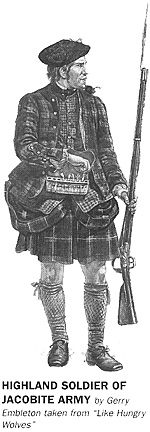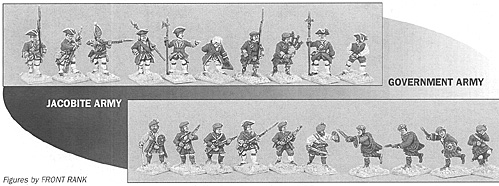
Many years ago, for those who can throw their minds back that far, the "back-to-back wargame" was often touted as a useful way of simulating the fog of war. It seems to have died a death some while back for no reason that I can fathom. Given that it is possible that a whole generation of wargamers may let this type of game pass them by I felt that it was time for an exhumation.
For those new to the hobby or who are looking bemused even at this point I'll go right back to basics and assume that the reader is new to the whole concept.
SET UP
The essence of a back to back game and the way in which it differs from a normal wargame (whatever that is) is that there are two identical tables. These tables are ideally separated by an opaque cloth. One army is set up on each table and only enemy troops who would be visible to that army are placed on its table. Each commander manoeuvres his own forces on his own table and an umpire pops from side to side of the cloth updating both commanders' views, adding and removing enemy troops as they move into or out of view. Combat calculations are made on the "home" table but casualties inflicted on the enemy come off the "away" table. Thus each commander knows how many men he has and where they are but not how many men the enemy has nor where they all are.
A quicker set up involves two tables and no cloth. Trust the players to face their own tables and not peek! The two commanders work literally back-to-back and do not have the freedom to move around the table that a cloth gives.
A third alternative for wargamers with better resources involves the two tables being in separate rooms. Make sure these are close together for the umpire's sake.
Whatever the set up - in all these situations the umpire has a master map of the terrain and only places terrain pieces on a table when the "home" army encounters them. Significant hills or obvious church spires for example may justify placing a terrain feature on both tables at the start of the game. The umpire will find that these act as useful points of reference later in the game.
USES
Any type of battle can be fought using this system but it is particularly valuable for recreating night actions and other situations with very restricted visibility, for example the wilderness campaign in the American Civil War. In this latter case the whole table can be deemed to be covered in trees and only other terrain features are placed. It's cheaper on scenery and you don't have to keep standing the damn model trees up! In general terms experience has shown that bearing the following points in mind helps:
- 1 Keep the terrain relatively simple.
2 The smaller the armies the easier the game from the umpire's point of view. Progress to bigger games later once you've got the mechanics right but by then you'll probably need two or more umpires.
3 Avoid rules with a multitude of range bands. The accuracy of the figure placement and terrain duplication doesn't allow for the "billimetre" player.
4 Terrain tiles act as a grid and are a great umpirical aid to both troop and terrain placement and movement.
5 Have a firm umpire. It is even more of a requirement than normal that what he says goes.
PHYSICAL SET UP
My better half was tasked with creating the opaque cloth and found some curtain lining material in a shop's remnants bin. This is lightweight and when hemmed along the top it was threaded with string to enable it to be suspended. The cloth doesn't need to be room height - from about 6 inches above the tallest player's head down to their knees is sufficient.
PRACTICALITIES AND PROBLEMS
Don't forget access to the loo and/or the bar for both sides. Players walking around with rulesheets over their faces desperately avoiding sight of the opponent's table but nevertheless trying to get quickly from A to B are not ideal particularly when with a bit of foresight this could have been avoided. If, like me, your club meets in a pub room, get the landlord's permission before you string up the cloth.
Our landlord, Kevin, is very amenable and when we've played this type of game on a club night the cloth is suspended between two opposite wall lights, splitting the room in two. The lights are sufficiently high up so that the cloth can block the players' view of the opposition and sufficiently well fixed to the wall so as to not cause embarrassing accidents.
Playing a game like this is great fun but can be lonely. The usual cross-table banter is absent. At least two players per side of the cloth alleviates this and often leads to deliberately loud whispers as (misleading) information is "given away". Quite what this represents I don't know but as long as everyone is enjoying themselves so what!
From a game organiser's point of view - remember that you'll need two of everything. It is always possible that everything will be involved at once but don't worry about exact duplication. Each "home" army should be as accurate as you normally are in face-to-face games but the appearing enemy don't need to be more than representative of their troop type. They are, after all, obscured by night or trees and so on. Use anything that gives the right idea. A man in a tricorn is a man in a tricorn, forget the uniform colour and facings. This is particularly true of more modern times.
The same premise goes for numbers. The "home" army should be aware that there are "a few", "about medium" or "lots" of enemy in a vicinity. The umpire can thus grab convenient numbers of figures from his duplicates store to give the right impression of the enemy on the "home" table but doesn't need to worry about an accurate count. Remember that the enemy's "home" table is always there for the real numbers.
If a commander actually crosses a piece of ground where the enemy took casualties then the umpire can give him information to the depth that would be available from general battlefield debris. "The casualties are all in civilian dress" or "all the prisoners have cartouche boxes with a 25 painted on.
They say that they are from the 25th line with Major General Lacrosse's brigade but know no more" and so on.
Rules changes are often required. As a starter try:
- 1 Reduced ranges or effectiveness at longer ranges.
2 +2 for each enemy rout etc. (Fine if in sight but ...)
3 Morale effects for un/favourable odds should be based on perceived odds rather than necessarily the real odds.
4 A morale effect for suprise. There's going to be a lot of it about.

Back to Back Wargames The Action at Clifton: December, 1745 by Derek Henderson
Back to Battlefields Vol. 0 Issue 0 Table of Contents
Back to Battlefields List of Issues
Back to Master Magazine List
© Copyright 1995 by Partizan Press.
This article appears in MagWeb.com (Magazine Web) on the Internet World Wide Web. Other military history and related magazines are available at http://www.magweb.com